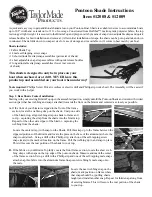
AA9x Series Single Channel Audio Controller
SM56 Installation and Operation Manual
May 22, 2012 Rev: 2.00
Page 2-2
ENG-FORM: 805-0100.DOTX
CONFIDENTIAL AND PROPRIETARY TO ANODYNE ELECTRONICS MANUFACTURING CORP.
2.4.2
Cautions
CAUTION:
Failure to follow the installation and wiring instructions provided in this manual
for power and ground connections, including the rating of the circuit breaker,
may lead to damage in the power input circuitry of the unit.
2.4.3
Cabling and Wiring
All wire shall be selected in accordance with the original aircraft manufacturer's Maintenance Instructions
or AC43.13-1B Change 1, Paragraphs 11-76 through 11-78. Unshielded wire types shall qualify to
MIL-W-22759 as specified in AC43.13-1B Change 1, Paragraphs 11-85, 11-86, and listed in Table 11-11.
For shielded wire applications, use Tefzel MIL-C-27500 shielded wire with solder sleeves (for shield
terminations) to make the most compact and easily terminated interconnect. Follow the connector map in
Section 2.7 as required.
Allow 3" from the end of the shielded wiring to the shield termination to allow the connector hood to be
easily installed. Reference the interconnect drawing in Section 2.7 for shield termination details. Note that
the hood is a "clamshell" hood, and is installed after the wiring is complete.
Maintain wire segregation and route wiring in accordance with the original aircraft manufacturers
’
Maintenance Instructions.
Unless otherwise noted, all wiring shall be a minimum of 22 AWG, except power and ground lines, which
shall be a minimum of 20 AWG. Reference the Interconnect drawing for additional specifications. Check
that the ground connection is clean and well secured, and that it shares no path with any electrically noisy
aircraft accessories such as blowers, turn and bank instruments or similar loads.
2.4.4
In-line PTT Cordsets
In-line, push-to-talk (PTT) cordsets (also known as drop cords) can be used to create/provide PTT
capability for the user headsets that do not have yoke or cyclic mounted PTT switches. For headsets
connected to the PILOT or COPILOT inputs/outputs of the AA9x series, ICS and TX keylines are needed
to properly activate the associated PTT circuitry inside the AA9x series. For headsets connected to the
PASSENGER inputs/outputs of the AA9x series, a method of controlling the microphone on the headset
is needed because of the 'hot mic' circuitry. This is best accomplished with a 'mic interrupt' switch in the
PTT cordset.
There are numerous manufacturers of in-line PTT cordsets, offering many 'electrical' variations to
accomplish different functions. To meet the operational requirements for headset stations supported by
the AA9x series, AEM recommends the dual switch type: a 3-position (momentary/center-off/locking)
slider switch for the ICS functions and a momentary push-button switch for the Transmit functions. Both
switches provide a ‘mic interrupt’ function. The 3
-position ICS switch will allow the user to change the
switch settings to match the operational intercom mode that has been selected at the AA9x series
(e.g., LIVE, KEYED or VOX). The cable should have 6 conductors with the MIC and PHONE pairs
shielded (MIC wires must be shielded as a minimum). To ensure proper shielding, the shield(s) should be
Summary of Contents for SM56 AA9 series
Page 18: ...Tony Pearson Designer Mar 7 2011 ...
Page 22: ......
Page 24: ...Confidential and Proprietary to NAT ...
Page 25: ...Confidential and Proprietary to NAT ...
Page 26: ...Confidential and Proprietary to NAT ...
Page 27: ...Confidential and Proprietary to NAT ...
Page 29: ......
Page 30: ......
Page 31: ......
Page 32: ......
Page 34: ......
Page 35: ......
Page 36: ......
Page 37: ......
Page 38: ......
Page 39: ......
Page 40: ......
Page 41: ......
Page 42: ......
Page 44: ......












































